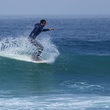more at http://sports.quickfound.net/
Shows surfing at Hermosa Beach, California, in 1947, in color. Also shows the construction of a surfboard. Silent. The Prelinger Archive original had large blank gaps in it, which I have removed, keeping all the actual footage in its original order.
see also: Surfing at Waikiki Beach, Oahu, Hawaii: "Sons of the Surf" circa 1920
https://www.youtube.com/watch?v=QUNh6dIqty0
Public domain film from the Prelinger Archive, slightly cropped to remove uneven edges, with the aspect ratio corrected, and mild color correction applied.
http://creativecommons.org/licenses/by-sa/3.0/
http://en.wikipedia.org/wiki/Surfing
Surfing is a surface water sport in which the wave rider, referred to as a "surfer," rides on the forward face of a wave, which is most often carrying the surfer towards shore. Waves suitable for surfing are found primarily in the ocean, but can be found in some lakes, in rivers in the form of a standing wave or tidal bore. Surfing can also be done in manmade sources such as wave pools and boat wakes. The term "surfing" refers to the act of riding a wave and not the form (with or without a board) in which the wave is ridden. For instance, the native peoples of the Pacific surfed waves on alaia, paipo, and other such crafts on their belly, knees, and feet. Not to mention, Bodysurfing, the act of surfing a wave without a board, is considered by some to be the purest form of surfing. That much said, the more modern day definition of surfing tends to refer to when a surfer rides a wave standing up on a surfboard, which is referred to as stand-up surfing or paddleboarding. Although, another prominent form of surfing in the ocean today includes bodyboarding, which refers to when a surfer rides a wave either on the belly, dropknee, or stand-up on a bodyboard. Not to mention, knee boarding, surfmatting (riding inflatable mats), foils, bodysurfing, and so forth.
Three major subdivisions within sitting -up surfing are longboarding, shortboarding, and stand up paddle surfing (SUP), reflecting differences in board design, including surfboard length, riding style, and the kind of wave that is ridden. In tow-in surfing (most often, but not exclusively, associated with big wave surfing), a motorized water vehicle, such as a personal watercraft, tows the surfer into the wave front, helping the surfer match a large wave's higher speed, which is generally a higher speed than a self-propelled surfer can obtain... Recently with the use of V-drive boats, wakesurfing, in which one surfs on the wake of a boat, has emerged. The Guinness Book of World Records recognized a 78 feet (23.8 m) wave ride by Garrett McNamara at Nazaré, Portugal as the largest wave ever surfed...
History and origins
For centuries surfing was a central part of ancient Polynesian culture. Surfing might have been first observed by Europeans at Tahiti in 1767 by Samuel Wallis and the crew members of the Dolphin who were the first Europeans to visit the island in June 1767. Another candidate is the botanist Joseph Banks being part of the First voyage of James Cook on the HMS Endeavour, who arrived on 10 April 1769 on Tahiti. Lieutenant James King was the first one who wrote about the art of surfing on Hawaii when completing the journals of Captain James Cook upon Cook's death in 1779.
When Mark Twain visited Hawaii in 1866 he wrote,
"In one place we came upon a large company of naked natives, of both sexes and all ages, amusing themselves with the national pastime of surf-bathing."
References to surf riding on planks and single canoe hulls are also verified for pre-contact Samoa, where surfing was called fa'ase'e or se'egalu (see Kramer, Samoa Islands) and Tonga far pre-dating the practice of surfing by Hawaiians and eastern Polynesians by over a thousand years.
George Freeth (November 8, 1883 -- April 7, 1919) is often credited as being the "Father of Modern Surfing". He is also thought to have been the first modern surfer.
In 1907, the eclectic interests of land baron Henry Huntington brought the ancient art of surfing to the California coast. While on vacation, Huntington had seen Hawaiian boys surfing the island waves. Looking for a way to entice visitors to the area of Redondo Beach, where he had heavily invested in real estate, he hired a young Hawaiian-Irish athlete, George Freeth, to demonstrate the art of surfing.
As a child in Hawai'i, Freeth had seen an old Polynesian painting that depicted his mother's ancestors riding surfboards. Freeth decided to revive the art of surfing But had little success with the huge 16-foot hardwood boards that were popular at that time. When he cut them in half to make them more manageable, he unwittingly created the original "Longboard", which made him the talk of the islands. To the delight of visitors, Freeth exhibited his surfing prowess twice a day in front of the Hotel Redondo...










